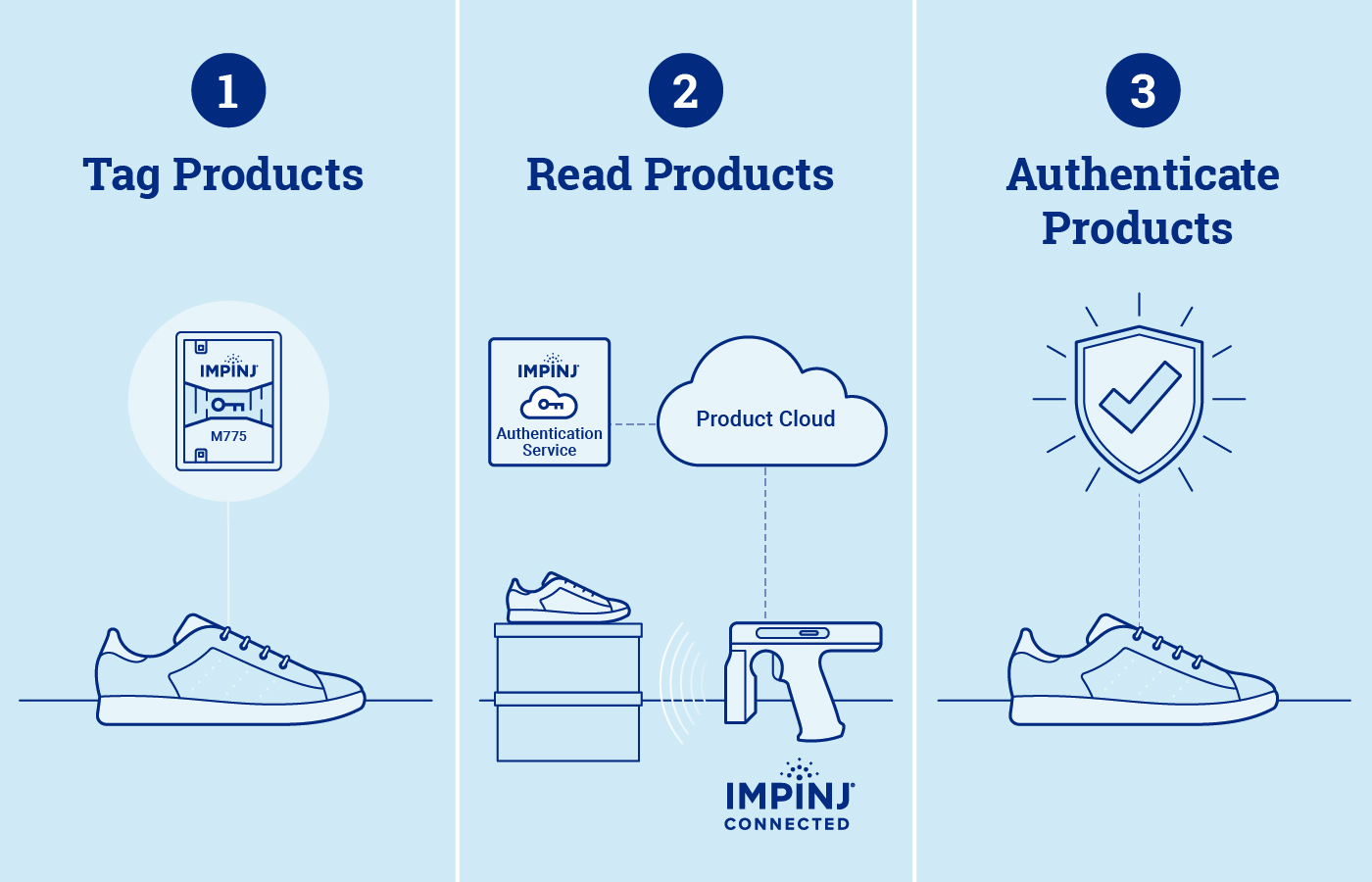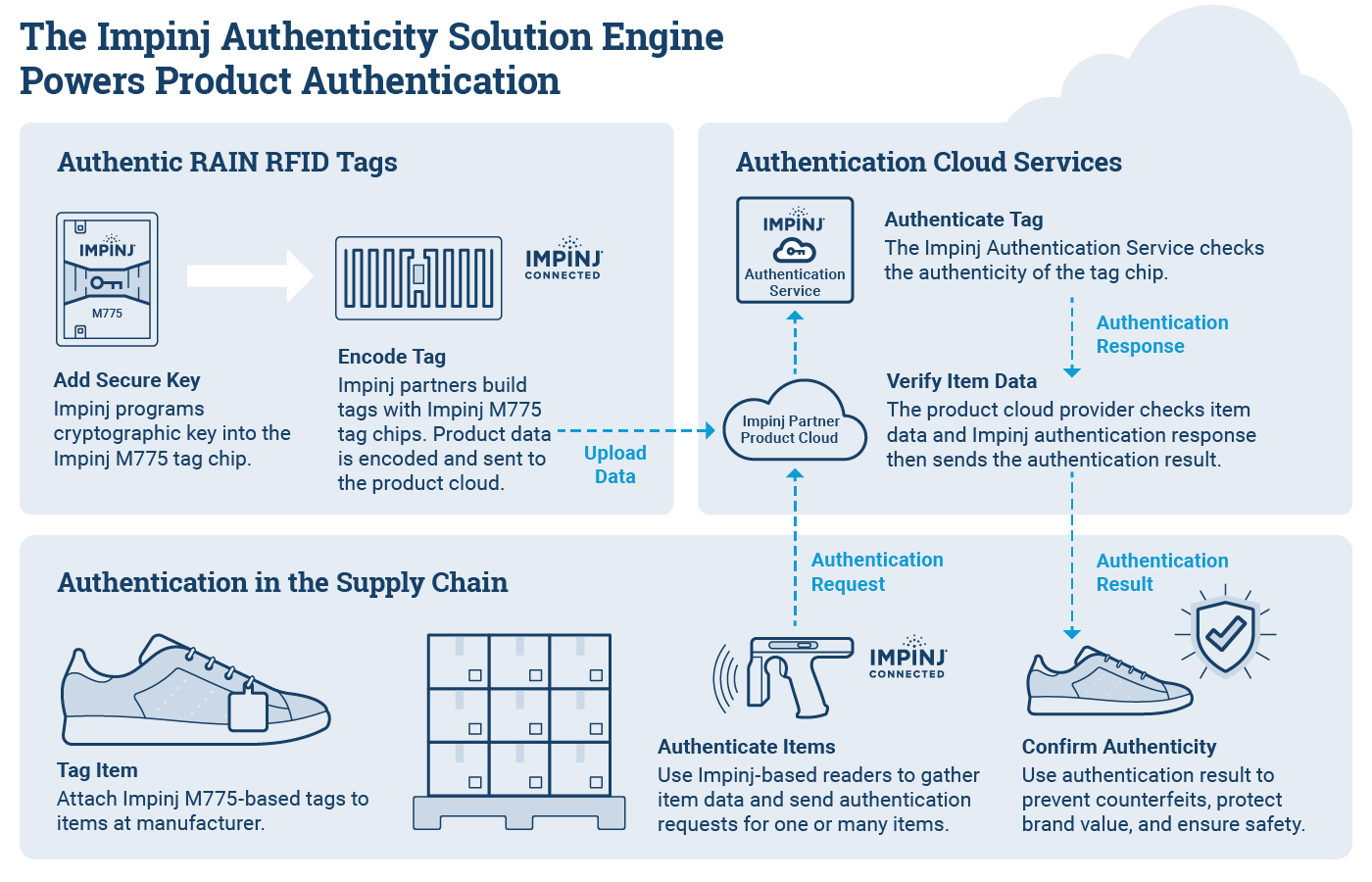What is RAIN RFID Product Authentication? Impinj Authenticity Explained
The Impinj Authenticity solution engine is a new way to authenticate products at enterprise speed and scale. Here are answers to frequently asked questions.
Leading enterprises in various industries worldwide are using RAIN RFID for inventory management, asset tracking, shipment verification, omnichannel fulfillment, and many more solutions.
Now RAIN RFID fights counterfeits, as well.
The Impinj Authenticity™ solution engine, launched in 2022, extends the value of existing RAIN RFID systems and enables authentication for a wide range of products, parts, and components. Authentication solutions built by Impinj partners help prevent counterfeits from entering the supply chain by enabling enterprises to swiftly authenticate items as genuine, in real-time and at scale.
But, what exactly is the Impinj Authenticity solution engine? How does it work? How secure is it? And why do we at Impinj believe RAIN RFID is the next big thing in authentication?
Below are answers to frequently asked questions about Impinj Authenticity and RAIN RFID product authentication. To learn even more, you can contact us at Impinj and/or check out some of our additional resources:
- Impinj Authenticity info page: All about the solution engine
- Product authentication info page: How RAIN RFID fights counterfeits
- Impinj Blog: Take Aim at Counterfeits with Impinj Authenticity Solution Engine
- Whitepaper: Combat Counterfeits with Secure, Scalable RAIN RFID-Based Solutions
- Video: How RAIN RFID Product Authentication Works
What is RAIN RFID product authentication?

RAIN RFID product authentication is a new method of verifying the authenticity of items at enterprise scale. RAIN RFID solutions have several advantages over traditional authentication technologies, offering better accuracy, reliability, cost, speed, and scalability within an enterprise and across an entire supply chain. To ensure a high level of security, the Impinj Authenticity solution engine uses cryptographic authentication to help businesses and governments combat counterfeits and secure supply chains.
What is RAIN RFID?
RAIN RFID is a passive, battery-free wireless technology that connects billions of everyday items to the internet. “RAIN” is a brand name denoting passive UHF RFID products and technologies that adhere to global standards. By placing RAIN RFID tags on items and reading those tags with RAIN RFID readers as they pass by, users can identify, locate, authenticate, and engage with every tagged item — providing rich, real-time data and insight. RAIN RFID can tell you what an item is, where it is, and even its condition. With this information, enterprises can increase sales, drive operational efficiencies, and improve customer experience. Solutions range from supply chain management to asset tracking to authentication of frequently counterfeited products.
What are traditional methods for verifying item authenticity?
Conventional technologies for verifying item authenticity include barcodes, digital watermarks, holograms, visual inspection, and near-field communication (NFC). Each has advantages and disadvantages. Of course, any sort of manual inspection is slow and prone to error. Barcode scanning is faster and more accurate than manual inspection, but still must be done with direct line-of-sight — as must any visual method, including holograms and digital watermarks. NFC is an RFID technology related to RAIN RFID, but NFC has a shorter read range and limited read rate.
How does RAIN RFID perform versus traditional authentication methods?
RAIN RFID solutions are highly accurate and reliable, and can authenticate items with great speed. Whereas barcodes require direct line-of-sight and can reach operational speeds of about 10 items per second, RAIN RFID can authenticate hundreds of items per second through barriers such as container walls. NFC can achieve about 20 items per second, and while it is also a type of RFID, NFC can only authenticate items from up to 1.5 meters away; RAIN RFID has a range of up to 10 meters. Meanwhile, RAIN RFID is more versatile than visual technologies — unlike barcodes or digital watermarks, RAIN RFID tags can be embedded into fabric, film, paper, ceramic, metal, and plastic. (Download our Impinj Authenticity whitepaper to view a technology comparison chart.)
What are the advantages of RAIN RFID for product authentication?
The most high-tech visual barcode readers can only authenticate items from up to 2 meters away; there’s a practical limit to how “small” of a barcode a reader can read, even with the best-resolution cameras. Because RAIN RFID has a read range of up to 10 meters, and because hundreds of tags can be read simultaneously, RAIN RFID offers more versatility and enables enterprises to authenticate items at far greater speed and scale. RAIN RFID chips, like those developed and manufactured by Impinj, cost just pennies — and while that’s not quite as inexpensive as printing a barcode, the additional operational optimization that RAIN RFID drives can unlock untold value. RAIN RFID already helps businesses maximize efficiencies and realize cost savings by enabling solutions for inventory management, supply chain automation, shipment verification, loss prevention, and more. Unlike barcodes, digital watermarks, holograms, or NFC, with RAIN RFID you can leverage a proven platform with a strong global ecosystem that is constantly developing new use cases.
How does RAIN RFID product authentication work?
It starts with the Impinj M775 RAIN RFID tag chip, each of which holds a cryptographic key. RAIN RFID tags featuring Impinj M775 tag chips are attached to products, parts, and other components. Along with its cryptographic key, each Impinj M775 chip holds a unique identifier that corresponds with product information in a cloud database. When a tagged item is read by an Impinj or partner RAIN RFID reader, the reader issues a cryptographic challenge to the tag, then sends that response to the cloud-based Impinj Authentication Service. Meanwhile, the system also looks up the tagged item’s identifying information against the product database. If all the data checks out and the system gets the responses it expects, the item can be confirmed as authentic. With RAIN RFID, businesses can detect counterfeits at various points in the supply chain, protecting their brands, safeguarding potential revenue, and preventing knockoffs — many potentially dangerous — from ever reaching consumers.
Where can RAIN RFID detect counterfeits?
Because it enables so many solutions at various points of a product’s journey — from manufacture to shipment to storefront and everywhere in between — RAIN RFID has the ability to authenticate items throughout the entire supply chain. At the point of manufacture, along production lines, at warehouse dock doors, in distribution centers, on delivery trucks, in store backrooms: If Impinj-based RAIN RFID is enabling item visibility, it can also enable authentication. Even at customer service, where retailers are seeing a rise of fraudulent returns. As the retail, supply chain, and logistics industries (among others like healthcare, aviation, and more) continue to expand their RAIN RFID infrastructures, businesses will be able to detect counterfeits at just about any point in their supply chain.
What else can RAIN RFID product authentication do?

Identifying potential counterfeits is just the start. The real-time visibility and historical data that enterprises gain with RAIN RFID enable enterprises to gain new efficiencies and optimize their processes. With powerful RAIN data, brand owners can identify which facilities have issues with fake products appearing, for example, or which product categories are more at-risk of copying. RAIN RFID can also help businesses see where products are more prone to “fall off the truck,” preventing genuine products from diverting to gray markets.
What is the Impinj Authenticity solution engine?
The Impinj Authenticity solution engine provides enterprises a foundation for protecting brands, protecting revenue, and protecting consumers by helping ensure products that reach the market are genuine. Impinj Authenticity leverages the whole Impinj platform, including RAIN RFID tag chips, reader chips, readers, cloud services, and the Impinj partner ecosystem. Using standards-based RAIN RFID and cryptographic methods, Impinj Authenticity enables streamlined development of enterprise IoT solutions.
The Impinj Authenticity solution engine comprises:
- Impinj M775 RAIN RFID tag chips connect individual items and enable partner services to quickly determine the connected item’s authenticity in addition to its identity. A cryptographic computation engine, combined with a unique cryptographic key in each tag chip, enables secure authentications while defending against malicious attacks.
- Impinj-based RAIN RFID readers scan hundreds of connected items simultaneously and send authentication requests to verify the connected items are genuine. Reader options include the Impinj R700 reader, along with partner reader devices built with Impinj E family reader chips.
- The Impinj Authentication Service verifies each tag chip’s authenticity in milliseconds. This cloud service uses standard, easy-to-use REST APIs to speed integration into partner and enterprise product authentication solutions.
Why is cryptographic authentication important for security?
Impinj Authenticy utilizes a cryptographic key to identify each Impinj M775 chip. These encrypted keys cannot be cloned or faked. That means RAIN RFID product authentication is more secure than visual technologies like barcodes or digital watermarks, which can be spoofed by bad actors. Impinj Authenticity uses universal GS1 UHF Gen2v2 and ISO standards-based authentication methods that are supported by a broad vendor ecosystem. Impinj cryptographic authentication is available on Impinj M775 RAIN RFID tag chips and fits seamlessly within existing inventory management, loss prevention, and supply chain processes. Here’s a deeper look at Impinj cryptographic authentication.
How is RAIN RFID product authentication evolving?
RAIN RFID has been around for decades and is a must-have IoT technology across industries, but it’s new to the world of product authentication. Most consumer smartphones can scan barcodes and read NFC tags, but don’t include RAIN RFID readers. However, at Impinj we dream of a future when everyday consumers can use RAIN RFID to authenticate something they buy — an expensive new watch, a key electrical component, or a lifesaving medication — with the phone in their pocket. It’s all part of our vision to enable a boundless Internet of Things.
For more information about the Impinj platform, Impinj products, and Impinj partner ecosystem, you can reach out to Impinj, view our informational resources, or subscribe to the Impinj blog.
Monday, June 26, 2023
ABOUT THE AUTHOR

Felix Klebe
Director, Product Marketing
As director of product marketing for Impinj, Felix Klebe leads product-related marketing and communication at Impinj, drawing on 25 years of experience in industrial product management and product marketing.
Sign Up for the latest news
